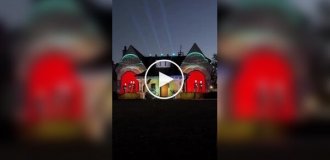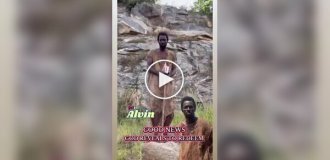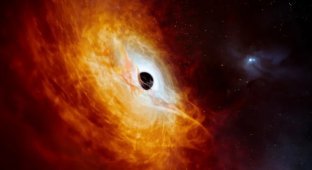Devouring one Sun a day. Scientists have found the fastest growing black hole (5 photos)
An international team of scientists from the Australian National University has discovered the brightest and fastest-growing supermassive black hole yet. It is located in a quasar located in the constellation Pictor. The black hole absorbs mass equivalent to the Sun every day, and its own mass exceeds the mass of the star itself by about 17 billion times. 
Australian scientists have found something unimaginable - the fastest growing black hole.
Object J0529-4351 is located 12 billion light years from Earth, and its mass is 17 billion times the mass of the Sun. This is stated in a study published in the journal Nature Astronomy.
Today, J0529-4351 is the brightest known object in the Universe. It shines 500 trillion times brighter than the Sun, said lead author of the study Christian Wolf.
The black hole was discovered as part of a study conducted in collaboration with the University of Melbourne and the Sorbonne University in France. It is noted that it absorbs mass equivalent to the Sun every day, and its own mass exceeds the mass of the Sun by about 17 billion times. Intense radiation comes from the accretion disk around the black hole, which contains all the matter that will inevitably be absorbed. The black hole's incredible growth rate also means it releases enormous amounts of light and heat. It is the brightest object in the Universe known to science. It is 500 trillion times brighter than our Sun. 
Mash Room, concerned about the good appetite of the black hole, talked to astrophysicist Mikhail Lisakov. The candidate of physical and mathematical sciences explained whether this giant celestial body is dangerous for planet Earth.
So, the first thing you need to understand is that object J0529-4351 is not a star, but a quasar. A huge black hole at the center of the galaxy, it is 20 billion times more massive than the Sun and larger in size than the Solar System. A lot of hot gas and stars revolve around it, and the glow traveled to Earth for more than 12 billion years. We know what a quasar looked like then, but we have no idea what's wrong with it now. 
Quasar J0529-4351 has a high emission power, but is located far away, which is why its light appears dim. To understand the difference between it and the star, you need a solid telescope. Such as in the Atacama Desert in Chile, with a diameter of as much as 10 meters. With its help, scientists saw that the quasar attracts stars and gas, and it became clear that this is not a simple celestial body. 
Since the black hole is far away, it does not pose a threat to the Earth. On the contrary, scientists have benefited from them. By observing quasars using radio telescopes, GLONASS/GPS systems were developed to accurately measure the Earth's rotation speed and detect the movement of continents. 
The quasar can be found in the southern hemisphere, in the constellation Pictor. Unfortunately, it is impossible to see such an object with the eye or with the help of an amateur telescope.
The ideal place for a huge spyglass is the far side of the Moon. From there you can find more amazing celestial bodies.




